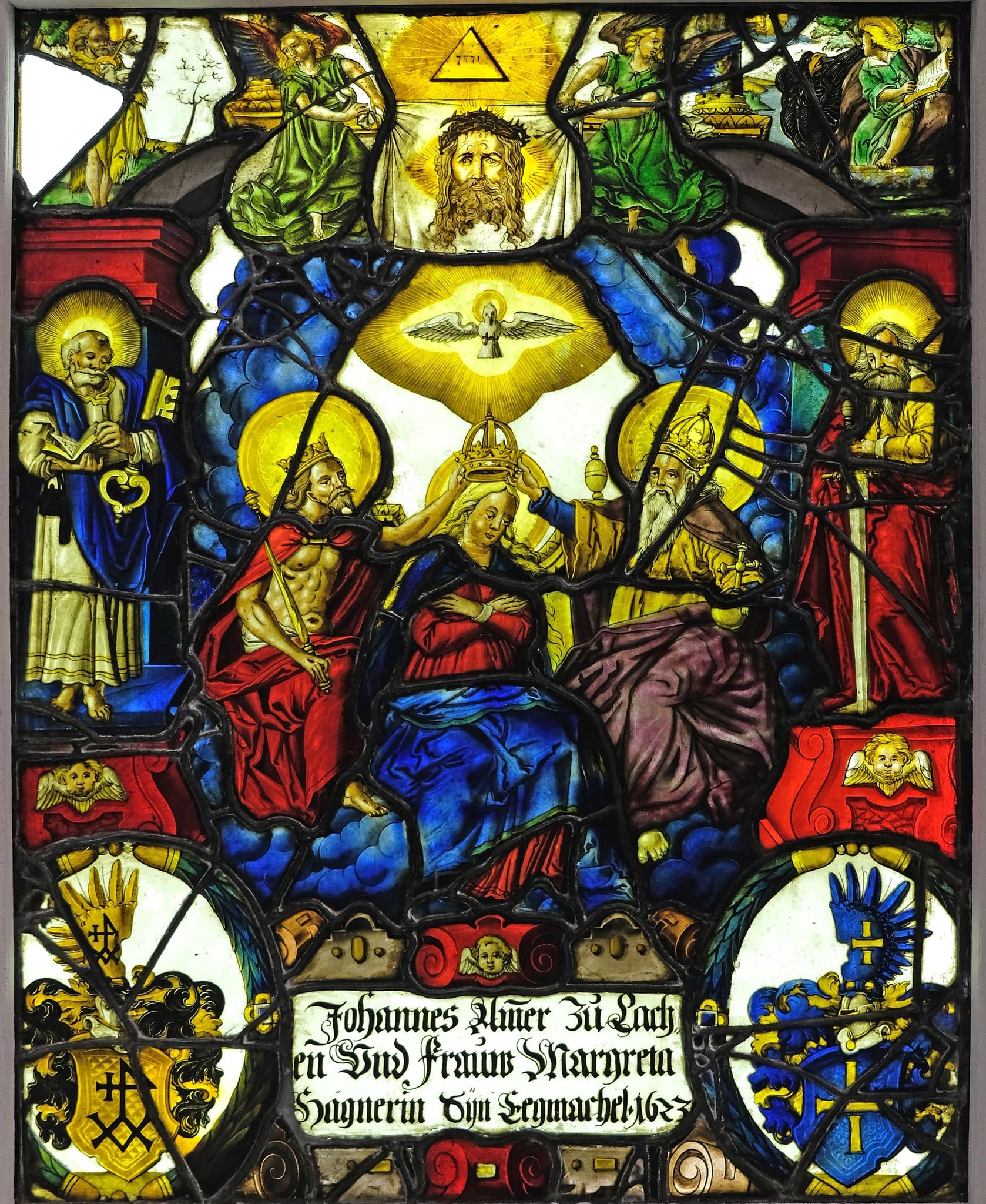The panel was made for the pilgrimage chapel of St. Jost (St. Jodoc) in Galgenen (Schwyz). In addition to its importance as a pilgrimage site, the chapel became associated with a revered layman, Niklaus von Flüe (Brother Klaus, 1417–1487) now cited as the patron saint of Switzerland. Niklaus was a respected and wealthy farmer who, after siring ten children, took up the life of a hermit and ultimately became a spiritual advisor. In 1622–1623, the dates of the window, the chapel was reconstructed in a Baroque style, although it conserved part of the earlier Gothic wall painting.
The restoration of the pilgrimage chapel of St. Jost included the donation of nine panels of heraldic glass between 1622 and 1624 (Jörger, 1978, 36–48). The names of the donors are listed in a Galgenen register of 1653. Johannes Ammer is noted as a Church Administrator (Kirchenvogt) in Lachen between 1596 and 1598. A member of an important family in the region, his father was Rudolf Ammer and his mother Adelheid Eebrecht. Johannes also gave a heraldic panel to the parish church of St. Conrad in Schübelbach, about six km southeast of Lachen. Margaretta Hegner was the daughter of Hans Hegner and Agatha Hasler (Jörger, 1978, p. 45). In 1835 the panels were sold (Jörger, 1978, 125). This panel, with four others, appeared in the 1843 sale of the Didier Petit collection from Lyon. Two from the sale are now in Princeton (y1961-54 and y1961-55). Another panel, showing the Virgin on the Crescent with images of John the Baptist and St. Margaret was acquired in 1978 by the March-Museum Vorderthal, Schwyz (Jörger, 1978, fig. 1). Photographs in the National Museum, Zurich, identify two others. In a private collection in Lucerne, a panel dated 1623, shows St. Giles and St. Margaret flanking the image of angels transporting the Holy House where Mary lived to Loreto (Jörger 1978, fig. 3). Another, now in the collection of the Wadsworth Atheneum, Hartford Connecticut, shows the Virgin holding the body of the dead Christ at the foot of the cross, flanked by saints John the Baptist and John the Evangelist (Jörger, 1978, fig. 4). The Parish archives in Galgenen possesses fragments of an additional window which was discovered under the pews in 1943 (Uta Bergmann).
Uta Bergmann has researched the long history of the glaziers of the city of Zug (Bergmann, 2004, 64–133). The family relevant to this panel began with Michael II Müller (ca. 1570–1642) son of the official Paul Müller (died 1611) who was the first glazier in Zug to leave an extensive record in the city archives and for whom signed panels remain. Michael Müller II was one of the glass painters who, following the death of Franz Fallenter, fabricated many of the panels in the Cloister of Rathausen. Tobias Müller was the oldest son of Michael Müller II (Bergmann, 2004, p. 95–97). Bergmann has suggested a number of panels from the Müller circle that could be the work of Tobias or his younger brother Paul. A panel of the Crucifixion with the Virgin and St. John dated to 1629 shows similar coloration, and distinctive bunched folds in the Virgin’s mantel as those forming the mantels of the Virgin and God the Father in the Princeton work (Cham, private collection; Bergmann, 2004, p. 297)
The window is an articulate representation of Catholic piety. St. Peter in the honored position to dexter (the viewer’s left) and St. Paul, refer to the authority of the Church as centered in Rome. The juxtaposition of John the Baptist and John the Evangelist at the top of the panel is quite similar to the composition used for a panel dated 1599 by the Winterthur artist Tobais Erhart an offered by Prior Johannes Eckstein of the Monastery of Ittingen (TG_73). The Easter antiphon: Regina caeli, laetare, alleluia; Quia quem meruisti portare, alleluia, Resurrexit, sicut dixit, alleluia: (Queen of heaven, rejoice, alleluia; The Son you merited to bear, alleluia; Has risen as he said, alleluia) appears in an antiphonary of about 1200 from St. Peter’s, Rome (Breitschneider, 1997, p. 1358). The composition of the image of the Coronation of the Virgin by the Trinity depends on the precedent set by Abrecht Dürer’s 1510 woodcut (Albrecht Dürer, The Assumption and Coronation of the Virgin, from The Life of the Virgin, The Metropolitan Museum of Art). The model was certainly well known; a closer match appears in a window given in 1573 to the Cloister of Muri. The donor Hans Müller commissioned the work from an unidentified Zurich glass painter (Hasler, 2002, pp. 96, 98, 207–208). The veil of St. Veronica, believed to have been imprinted with the image of Christ when he wiped his face just before his death, was one of the most venerated relics in St. Peter’s Basilica. The popularity of the relic developed in the Latin West after the conquest of Constantinople and plunder of its relics in 1204 during the Fourth Crusade (Wolf, 1997, pp. 153–79).
Cited in:
Didier Petit sale, 1843, 32, no. 304.
Record of the Art Museum, 1963, p. 19
Raguin and Morgan, 1987, p. 85.
